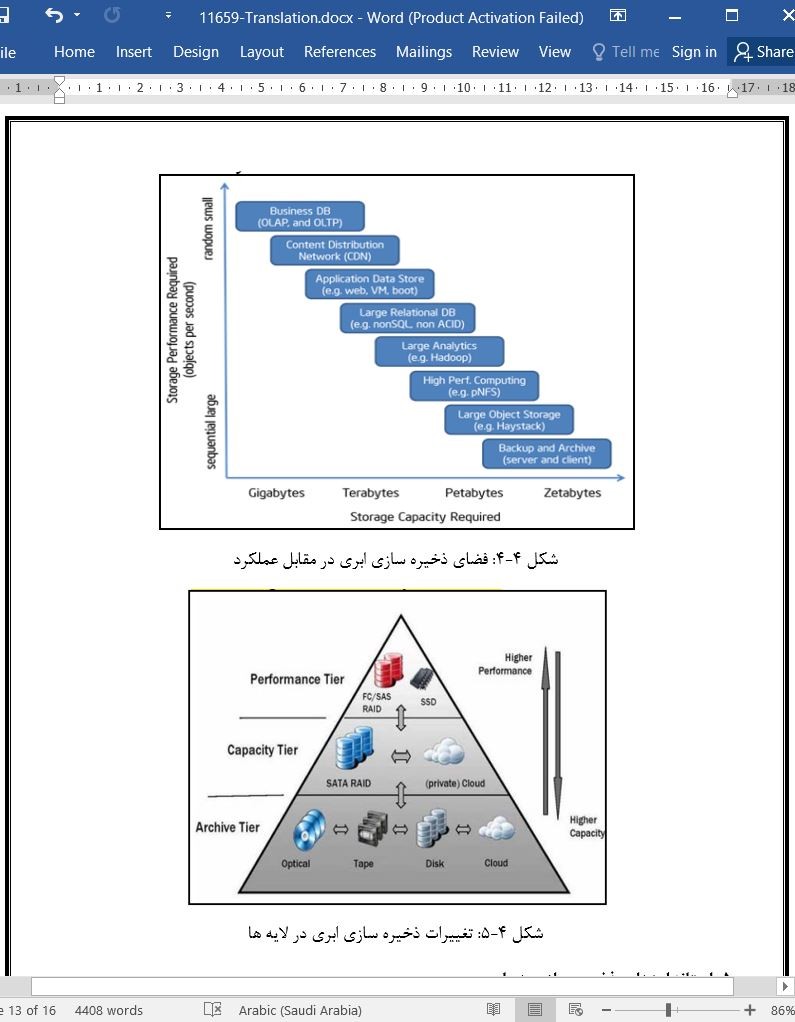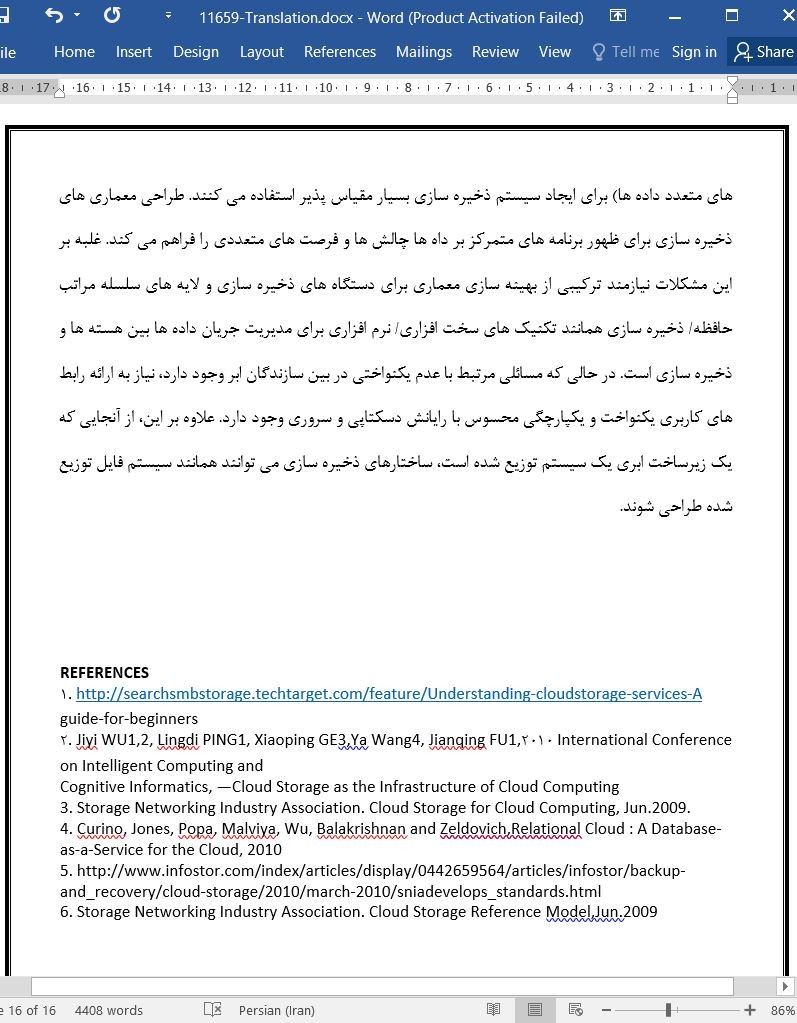
معماری ذخیره سازی در فضای ابری
چکیده
طراحی معماری های ذخیره سازی برای برنامه های در حال ظهور متمرکز بر داده ها فرصت ها و چالش های متعددی را ارائه می کند. البته غلبه بر این مشکلات نیازمند ترکیبی از بهینه سازی ساختارها برای دستگاه های ذخیره سازی و لایه های معماری حافظه/ ذخیره سازی و همچنین تکنیک های سخت افزاری/ نرم افزاری برای مدیریت جریان داده ها بین هسته ها و ذخیره سازی است. با توجه به این که وارد حوزه ای می شویم که داده ها نقش اصلی را در طراحی معماری ایفا می کنند، بهینه سازی معماری ذخیره سازی مهم تر از اهمیت بیشتری برخوردار خواهد شد. معماری ذخیره سازی ابری موضوع مهمی است چرا که کاربرد داده ها و ظرفیت ذخیره سازی در هر سال دو برابر می شود. بنابراین برخی از شرکت های مهم اساساً بر درخواست ذخیره سازی همانند ذخیره سازی ابری متمرکز شده اند. ارائه دهندگان فعلی ذخیره سازی در فضای ابری بیشتر بر عملکرد، مسائل هزینه ای و گزینه های متعدد ذخیره سازی متمرکز شده اند.
مقدمه
مراکز داده رایانش ابری براساس یک زیرساخت ساده طراحی برای از کار افتادگی مدل سازی می شوند. آن ها از راهکارهای کم هزینه، هدفمند و مقیاس پذیر از جمله سرورها، سیستم های ذخیره سازی و محصولات شبکه استفاده می کنند، در حالی که همچنان مدل های استاندارد تحویل را به کار می گیرند. با این حال، مراکز داده رایانش ابری سیستم های طراحی شده برای بازار سنتی فناوری اطلاعات را خریداری نمی کنند. این محصولات بسیار گران قیمت هستند و دربرگیرنده ویژگی هایی هستند که با محیط منحصر به فرد مرکز داده ابری و نیازمندی های برنامه سازگار نیستند.
6. نتیجه گیری
ذخیره سازی ابری همراه با تعهد وسیع برای اجرای سیستم های فایل طراحی نمی شوند اما در عوض بسیار مقیاس پذیر هستند و مدیریت سیستم های ذخیره سازی ساده است. آن ها از روش متفاوتی برای انعطاف پذیری داده ها، آرایه اضافی نودهای ارزان قیمت، در ترکیب با سیستم فایل های مبتنی بر شی یا شبیه شی یا تکرار داده ها (نسخه های متعدد داده ها) برای ایجاد سیستم ذخیره سازی بسیار مقیاس پذیر استفاده می کنند. طراحی معماری های ذخیره سازی برای ظهور برنامه های متمرکز بر داه ها چالش ها و فرصت های متعددی را فراهم می کند. غلبه بر این مشکلات نیازمند ترکیبی از بهینه سازی معماری برای دستگاه های ذخیره سازی و لایه های سلسله مراتب حافظه/ ذخیره سازی همانند تکنیک های سخت افزاری/ نرم افزاری برای مدیریت جریان داده ها بین هسته ها و ذخیره سازی است. در حالی که مسائلی مرتبط با عدم یکنواختی در بین سازندگان ابر وجود دارد، نیاز به ارائه رابط های کاربری یکنواخت و یکپارچگی محسوس با رایانش دسکتاپی و سروری وجود دارد. علاوه بر این، از آنجایی که یک زیرساخت ابری یک سیستم توزیع شده است، ساختارهای ذخیره سازی می توانند همانند سیستم فایل توزیع شده طراحی شوند.
Abstract
Designing storage architectures for emerging data-intensive applications presents several challenges and opportunities. Tackling these problems requires a combination of architectural optimizations to the storage devices and layers of the memory/storage hierarchy as well as hardware/software techniques to manage the flow of data between the cores and storage. As we move deeper into an era in which data is a first-class citizen in architecture design, optimizing the storage architecture will become more important. Cloud Storage Architecture is major topic in now a day because the data usage and the storage capacity are increased double year by year. So that some of the major companies are mainly concentrated on demand storage option like cloud storage. The existing cloud storage providers are mainly concentrated on performance, cost issues and multiple storage options.
Introduction
Cloud computing data centers are modeled upon a simple design-for-failure infrastructure. They use low-cost, purposebuilt, scalable solutions, including servers, storage systems and networking products, while still utilizing standard delivery models and massive economies of scale. Cloud computing data centers, however, do not purchase off-the-shelf systems designed for the traditional mass-IT market. These products are too expensive and include features that do not meet the cloud’s unique data center environment and application requirements.
CONCLUSION
Cloud Storage with a great deal of promise, aren’t designed to be high performing file systems but rather extremely scalable, easy to manage storage systems. They use a different approach to data resiliency, Redundant array of inexpensive nodes, coupled with object based or object-like file systems and data replication (multiple copies of the data), to create a very scalable storage system. Designing storage architectures for emerging data-intensive applications presents several challenges and opportunities. Tackling these problems requires a combination of architectural optimizations to the storage devices and layers of the memory/storage hierarchy as well as hardware/software techniques to manage the flow of data between the cores and storage. While there are issues of non-uniformity across cloud vendors there is a requirement to provide uniform user interfaces and seamless integration with the mainstream desktop and server computing. Moreover, since a cloud infrastructure is a distributed system, storage facilities may be designed like the distributed file system.
چکیده
مقدمه
1. مدل های پیاده سازی
A. ابر خصوصی
B. ابر اشتراکی
C. ابر عمومی
D. ابر ترکیبی
2. ذخیره سازی به عنوان یک ابر سرویس دهی
انواع سیستم های ذخیره سازی ابری
A. سیستم های ذخیره سازی شی
B. سیستم های ذخیره سازی دیتابیس ارتباطی (RDS)
3. معماری های ذخیره سازی ابری
4. طراحی ذخیره سازی به عنوان ابر سرویس
A. امنیت
B. ذخیره سازی خودکار ILM
C. روش دسترسی به ذخیره سازی
D. قابلیت دسترسی
E. حفاظت از داده های اصلی
F. چابک بودن ذخیره سازی
G. عملکرد
H. مقیاس پذیری
5. استانداردهای ذخیره سازی در ابر
A. مشترکان ذخیره سازی ابری (کاربران)
B. ارائه دهندگان سرویس ذخیره سازی ابری
C. توسعه دهندگان سرویس ذخیره سازی ابری
D. تفکیک کنندگان سرویس ذخیره سازی ابری
6. نتیجه گیری
منابع
Abstract
Introduction
I. DEPLOYMENT MODELS [2]
A. Private Cloud
B. Community Cloud
C. Public Cloud
D. Hybrid Cloud
II. STORAGE AS SERVICE CLOUD [3,4]
A. Object Storage Systems
B. Relational Database Storage Systems (RDS)
C. Distributed File Storage Systems
III. CLOUD STORAGE ARCHITECTURES [3,4]
IV. STORAGE AS SERVICE CLOUD DESIGN VIEW(4,5)
A. Security
B. Automated ILM Storage
C. Storage Access Method
D. Availability
E. Primary Data Protection
F. Storage Agility
G. Performance
H. Scalability
V. CLOUD STORAGE STANDARDS [5]
A. Cloud storage subscribers (users)
B. Cloud storage service providers
C. Cloud storage service developers
D. Cloud storage service brokers
CONCLUSION
REFERENCES
- اصل مقاله انگلیسی با فرمت ورد (word) با قابلیت ویرایش
- ترجمه فارسی مقاله با فرمت ورد (word) با قابلیت ویرایش، بدون آرم سایت ای ترجمه
- ترجمه فارسی مقاله با فرمت pdf، بدون آرم سایت ای ترجمه



